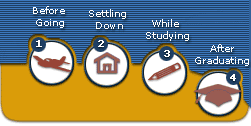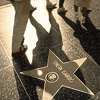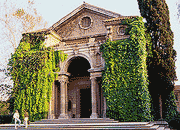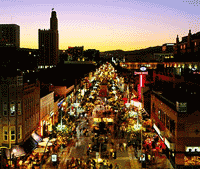 |
 |
 |
 |
 |
 |
 |
| Privacy Policy |
| Disclaimer |
| Terms & Conditions |
|
Study in USA: Los Angeles
STUDYING IN LA Some of the best colleges and universities in America lie hidden among the skyscrapers of Los Angeles or are located in the valleys of the city's immediate vicinity. Before you pack your bags and head out to one of the largest cities in the world, however, you should be warned against the overwhelming size of this bustling metropolis. Moving around the city is practically impossible without a car, people moreover spend hours daily in the traffic. But for those who cherish the spirit of adventure and youth, all of the above setbacks can be just a part of a thrilling journey! The University of California at Los Angeles (UCLA) is the biggest university in the area. A part of the extensive network of The University of California System, it is one of the best public universities not only in California, but also in the United States. Founded in 1919 as only a small branch, it now has over 36,000 undergraduate and graduate students and offers degrees in over 100 fields. Its Ph.D. programs are ranked among the best in the nation, attracting some of the best professors and scholars. Most of the campus is located in the heart of LA, thus offering limitless opportunities to its students. Yet, UCLA is known for its great and huge on-campus parties, which draw students from other schools as well.
The northeastern outskirts of Los Angeles basin lies some of the best private schools of the nation - the Claremont Colleges. Established in 1925, the Claremont Colleges now includes five undergraduate and two graduate institutions that work in close cooperation to provide their students with the best of two worlds: the personal values of a small college and the rich opportunities of a big university.
Claremont McKenna College (CMC) has a strong emphasis on economics and political science, ranking among the best in the field. Enrollment is also rather small: about 1,000 students. Many banks and financial institutions are drawn to CMC each year to select their future employees, whose success is undoubtedly evidenced from the huge endowment of the school. Harvey Mudd College (HMC) offers the top physical sciences and engineering degrees in the U.S. Most of the 700 HMC graduates normally continue to Ph.D. programs in their respective field. HMC also offers a fifth-year master-of-engineering degree, but competition is rather fierce as only five to ten students are selected each year.
Scripps College
is one of the few women-only colleges in America.
The last undergraduate institution, Pitzer College specializes mostly in the behavioral and social sciences. Enrollment is nearly 900 students, who keep up with the school's heritage of the 1960s focusing on personal growth within a community setting. The Claremont Graduate University (CGU), founded in 1925, offers a wide array of degrees, namely in the arts, education, organizational and behavioral sciences, the humanities, information science, politics, economics and management. Its enrollment is over 2,300 students, but only about 600 of them are full-time students. Hence, unlike the largely residential undergraduate colleges, CGU students are more spread out in the area. The newest member of the consortium is the Keck Graduate Institute (KGI), which joined in year 2000. It is the first U.S. graduate institution dedicated exclusively to the biosciences and their applications in life, and it has yet to show its full capacity. LIVING IN LA
Los Angeles is famous for its beautiful beaches lined with palm trees and long shopping
streets. The large and spacious Santa Monica Bay will not disappoint anyone in this respect.
Starting out from its northern part, Malibu is the first attraction along the way. The beach and the
pier are not that impressive at first glance, but if you take a walk into the mainland, you will
discover plenty of large mansions where many celebrities seek some peace. The Malibu Colony Plaza is
the best place for star-spotting! Moving south, the Santa Monica Beach is the oldest and biggest
beaches in LA. Packed on weekends, it is relatively quiet during the week and is an ideal place for
roller-blading, biking, and walking along the ocean. The
Santa Monica Promenade is an adorable place for shopping and one of the few pedestrian-friendly
places in Los Angeles. Further south is situated the famous Venice Beach.
Once you get to Venice, The city's real self, however, is downtown. It's a poorly defined area, but can be instantly recognized by the skyscrapers and small shops right on the sidewalk. The area is known to be a dangerous place, so go there during the day just to see the peculiar mixture of everything from Art Deco to punk and hard rock. In the west, you can find glamorous Hollywood, which has long been lacking its previous beauty. The stars on the sidewalks near the Chinese Theatre are still worth seeing, but don't expect much more from Hollywood. The beautiful mansions of celebrities and all sorts of stars are hidden on the nearby hills, and the area is definitely not a hangout place. West Hollywood can offer some of the best bars and clubs in the area, most of which are clustered along Sunset Boulevard. Many students go there during the weekend, although most places require you to be over 21. Beverly Hills, one of the richest neighborhoods of LA, is also exceptionally beautiful, with many trees and flowers all aver. Its hallmark, Rodeo Drive, is where "Pretty Woman" was shot and is a must-visit location for anyone in the area. Occasionally, students are spotted window-shopping there, even though it's too expensive for real shopping. In general, bars and clubs cater exclusively to people over 21. However, if you find going to bars and pubs are too expensive, most students usually visit one of the parties or activities on campus, or go to the movies together.
|
 |
| ||||||||||||||||||||||||||||||
|
| ||||||||||||||||||||||||||||||
Home | About iStudentCity | Job Opportunities | Contact iStudentCity Hall
Copyright©2000-2009, iStudentCity.com. All Rights Reserved.
 Los Angeles, a rambling metropolis with millions of people, has come to be known as an enticing
city of limitless opportunities. Intimidating, yet charming, confusing, yet adorable, strange,
yet inexplicably familiar - this is how LA can be described at the advent of the twenty-first
century. Attributing most of its fame to Hollywood and Walt Disney, LA attracts tens of
thousands of international students each year and certainly has more to offer than just the
flamboyant images of the film industry.
Los Angeles, a rambling metropolis with millions of people, has come to be known as an enticing
city of limitless opportunities. Intimidating, yet charming, confusing, yet adorable, strange,
yet inexplicably familiar - this is how LA can be described at the advent of the twenty-first
century. Attributing most of its fame to Hollywood and Walt Disney, LA attracts tens of
thousands of international students each year and certainly has more to offer than just the
flamboyant images of the film industry.
 The other big university in the very heart of Los Angeles is the
The other big university in the very heart of Los Angeles is the 
 Its core curriculum focuses on the humanities
and is devoted to preparing its 900 women for the
challenges and dynamics of modern life. The beautiful residential campus certainly reflects the
pursuit of a broad, rather than just an academic education.
Its core curriculum focuses on the humanities
and is devoted to preparing its 900 women for the
challenges and dynamics of modern life. The beautiful residential campus certainly reflects the
pursuit of a broad, rather than just an academic education.
 Among the young cities of the United States, Los Angeles still offers more than most
cities in the country. It's not much of an arts and museum city, but is striving to cater to
different tastes. Museum connoisseurs will fall in love with the enormous
Among the young cities of the United States, Los Angeles still offers more than most
cities in the country. It's not much of an arts and museum city, but is striving to cater to
different tastes. Museum connoisseurs will fall in love with the enormous
 you'll see the whole world blending there. From the colorful shops along the beach to the clowns, the
jugglers and the fire-eaters, Venice will take your heart forever with its myriad circus-like
personalities. Beware at night, however, because Venice is taken over by street gangs,
and can be quite a dangerous place.
you'll see the whole world blending there. From the colorful shops along the beach to the clowns, the
jugglers and the fire-eaters, Venice will take your heart forever with its myriad circus-like
personalities. Beware at night, however, because Venice is taken over by street gangs,
and can be quite a dangerous place.
 Los Angeles also has a lot of amusement parks:
Los Angeles also has a lot of amusement parks: 